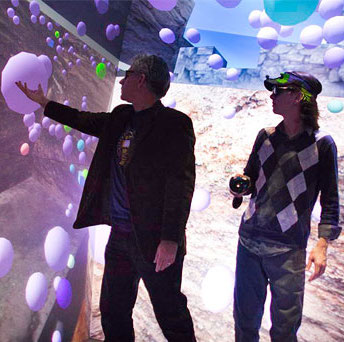Qualcomm Institute: Year In Review 2015
By David Wang
San Diego, December 18, 2015 -- The end of the year calls for a review of all that has happened at the Qualcomm Institute, also known as the UC San Diego division of the California Institute for Telecommunications and Information Technology (Calit2). We begin with a toast that was raised to commemorate the institute’s 15th year, when Atkinson Hall was opened to the public for an Open Labs and Demos session from nearly a dozen research groups. In case you missed the celebration, we have recreated what it's like to experience the Qualcomm Institute with a list of our top stories for each month of 2015. For more details, click on the headline to read the full article or news release. Enjoy!

DECEMBER
UC San Diego's Thomas E. Levy Among Recipients of President's Research Catalyst Award
Qualcomm Institute affiliate Thomas E. Levy of the UC San Diego Department of Anthropology is one of the recipients of the 2016 Research Catalyst Awards. Levy's $1.07 million project will leverage the Pacific Research Platform — a 10-100Gb/s networking platform — to curate, analyze and visualize 3D data from at-risk archaeological sites all over the world.

NOVEMBER
Healthy Aging Initiative at UC San Diego Announces Inaugural Research Projects
The Healthy Aging Initiative (HAI), a campus-wide effort to investigate and address the diverse challenges and needs of the nation’s aging population, has announced its inaugural research and education seed grants to seven UC San Diego faculty members.

OCTOBER
Actual Reality Beckons at Conference on Future of Virtual Reality
About a week before researchers gathered at the UC San Diego for a conference on the “Future of Virtual Reality,” actual reality was unfolding, albeit tragically, in the Syrian City of Palmyra. With the right images and photogrammetry techniques, the Temple could one day be recreated as it looked before it was destroyed – not in marble or stone, but in virtual reality.

SEPTEMBER
NSF Locates National Nanotechnology Coordinated Infrastructure Site at UC San Diego
The National Science Foundation has selected UC San Diego to be one the first university sites in the new National Nanotechnology Coordinated Infrastructure (NNCI). The agency will fund $1.1 million annually over five years to advance nanoscale science and engineering and develop transformative nanotechnologies and nanotechnology-based startups.

AUGUST
NSF Gives Green Light to Pacific Research Platform
NSF is funding a $5 million, five-year award to UC San Diego and UC Berkeley to establish a Pacific Research Platform (PRP), a science-driven high-capacity data-centric “freeway system” on a large regional scale. Within a few years, the PRP will give participating universities and other research institutions the ability to move data 1,000 times faster compared to speeds on today’s inter-campus shared Internet.

JULY
Engineers Give Invisibility Cloaks a Slimmer Design
In a new study, electrical engineers at UC San Diego have designed a cloaking device that is both thin and does not alter the brightness of light around a hidden object. The technology behind this cloak will have more applications than invisibility, such as concentrating solar energy and increasing signal speed in optical communications.

JUNE
Electrical Engineers Break Power and Distance Barriers for Fiber Optic Communication
The research carried out by the Qualcomm Institute's Photonic Systems Group has broken key barriers that limit the distance information can travel in fiber optic cables and still be accurately deciphered by a receiver. The advance has the potential to increase the data transmission rates for the fiber optic cables that serve as the backbone of the internet, cable, wireless and landline networks.

MAY
5G Wireless Forum: The Promise and the Peril of Future Wireless Systems
The format for the 5G Forum on Next-Generation Wireless Systems and Applications, held at the UC San Diego, was a reflection of the two poles — the promise and the peril — that define the future of wireless technology. If all goes according to plan, the next decade of advances in mobile technology promises to transform a vast array of sectors, from government to transportation to public health.

APRIL
Composer in Residence Shortlisted for Pulitzer Prize for Music
Xiaoxiang refers to the region in China’s Hunan Province where the rivers Xiao and Xiang intersect. It is also the title of a concerto for alto saxophone and orchestra composed by UC San Diego music professor and Qualcomm Institute composer in residence Lei Liang. The work was one of three finalists for the 2015 Pulitzer Prize for Music.

MARCH
Qualcomm Institute Launches Industry Innovation Space on UC San Diego Campus
Working closely with other campus entities to translate ideas from the lab into products and companies in the marketplace, the Qualcomm Institute has launched an Innovation Space where qualified faculty startups, industry partners or national laboratories can lease office or lab space inside the research institute’s headquarters building on the UC San Diego campus.

FEBRUARY
Making the Past Present with Light, Warmth and a High-Tech Gaze
Two UC San Diego students were invited by the Museo dell’Opera del Duomo to conduct a structural 'health assessment' of the Baptistery of St. John, which was completed in 1128. Their resulting 3D digital model depicts a building that has aged gracefully, yet warrants careful and continued evaluation.

JANUARY
PDEL: Qualcomm Institute’s 'Gateway to the Social Sciences'
The world-class social science research that goes on at the UC San Diego and the technology innovation that takes place at the Qualcomm Institute might seem, at first glance, completely unrelated. But the two are converging with the emergence of the UC San Diego groundbreaking Policy Design and Evaluation Lab (PDEL).
Media Contacts
Tiffany Fox
(858) 246-0353
tfox@ucsd.edu

